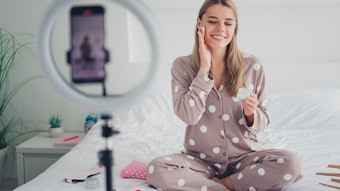
Moisturizers: those ubiquitous skin care products that can be found on almost any bathroom counter from Milan to Shanghai. They come with various functions and price tags, but moisturizers have long served as the basis of myriad beauty routines.
The time has come for a new countertop staple. Although moisturization and UV protection have been focal points of cosmetic education for decades, the future direction of our industry is trending toward something new: holistic protection. Holistic protection encompasses defense of our skin from the environment and harmful chemicals, but also protection of the environment itself.
Soon, bathrooms around the world will no longer boast a homely drugstore moisturizer, but rather a sustainable multifunctional protection product.
Meet the Hyper-cautious Consumer
Holistic protection is just beginning to rise to the top of our minds. This upsurge began as a collection of individual trends: health and beauty convergence, plant-based ingredients, and green and sustainable cosmeticsa,b,c.
The common denominator among these trends is the enlightened consumer, who is hyper-cautious about which ingredients they put on their faces and bodies and what packages they toss in the trash. This weary consumer has driven a preventative movement that is centered on the aptly labeled precautionary principle.
Cosmetics & Toiletries and Global Cosmetic Industry are right on the money when they state that precautionary consumers are “resist[ing] the introduction of ingredients, processes and products with unknown or disputed impactsd.” However, while this article specifically attributes the precautionary principle to the clean beauty sphere, we should step back and look at the bigger landscape.
Hyper-cautious consumers are enabling not just the single trend of clean beauty, but rather defining the current state of the entire industry. What we are witnessing is not a discrete market niche that cares solely about clean beauty or plant-based ingredients—this is a comprehensive movement of cautious consumers who want products that offer holistic protection against all forms of potential harm.
Holistic Protection’s Growing Checklist
How is this precautionary movement manifesting itself on the product end? Savvy brands have already found the answer: holistic protection products. While we used to emphasize only UV protection, we are now expanding to visible light and infrared protection. While we used to fixate on recyclable packages, we are now expanding to sustainable formulas and supply chains as well. In a nutshell, we are expanding the definition of protection in our industry.
Our effort to protect consumers and the environment billows larger and larger as we try to encompass every potential hazard, but to avoid scattering our focus, we can boil down holistic protection into three components:
- Protecting the consumer from environmental stressors
- Protecting the consumer from harmful cosmetic ingredients
- Protecting the environment from waste and resource degradation
As an industry, if we begin to acknowledge these trends as part of the same overarching movement toward holistic protection, we can start defining best practices to help us prioritize and avoid misinforming the consumers.
1. Protection from Environmental Stressors
Environmental stress has long been a target of the cosmetic industry, but the precautionary movement brings an expanded list of stressors that consumers must defend against. Relatively new areas of concern include microbiome balance and anti-pollution skin care, but we are also witnessing new tricks to defend against the longstanding concern of UV radiatione.
A key trending environmental stressor is blue light. Blue light protection cosmetics have become a hot topic in the context of “digital aging,” or the concern that excess screen time will exacerbate skin aging. This light source is portrayed as a new and sensational danger in today’s digital age. Not only have protective cosmetics flooded the marketf, consumers have also been urged to reduce screen time.
Unfortunately, consumers aren’t hearing the whole story about blue light. A growing array of clinical research supports the notion that blue light can cause photodamage to the skin by generating oxidative stress, hyperpigmentation or collagen degradation via multiple pathways. However, this damage is strongly dependent on the dose and wavelength of blue light.
This caveat illustrates two problems. Firstly, most studies on blue light damage were run at high-intensity for short durations, and therefore may not accurately model long-term blue light exposure. Short-term oxidative stress cannot be extrapolated to lasting skin damage. The second issue is the dose of blue light; even on a cloudy day, the intensity of blue light radiation from the sun is at least six times the dose from indoor devices.
Therefore, “digital aging” is a misleading term because it exaggerates the impact of screen time. Long-term blue light-induced skin damage, if any, would more likely be caused by excessive exposure to direct sunlight than by digital screens.
The blue light trend illustrates the ways in which a valid concern about photodamage was spun out of proportion into a story about digital aging. If anything, the industry needs to focus on solar protection instead of smartphones.
Many forward-thinking brands are already integrating blue light protection into their broad-spectrum sunscreens, and yet the digital aging lore continues to perpetuate itself. Although we are moving in the right direction of holistic protection with truly broad-spectrum sun products, we are leaving collateral misinformation in our tracks that may amplify problems in the future.
Footnotes:
a“13 big beauty trends for 2019,” www.harpersbazaar.com/uk/beauty/skincare/a25568595/beauty-trends-2019/
b“The Six Biggest Skin-Care Trends and Innovations Coming in 2019,” www.allure.com/story/skin-care-trends-innovations-2019
c“13 Trends Shaping the Face of Beauty in 2018,” www.cbinsights.com/research/report/beauty-trends-2018/
Defense of body and planet have fused into a holistic mission.
dJeb Gleason-Allured and Rachel Grabenhofer, “Clean Beauty Decoded,” www.cosmeticsandtoiletries.com/research/methodsprocesses/Clean-Beauty-Decoded-510077751.html











